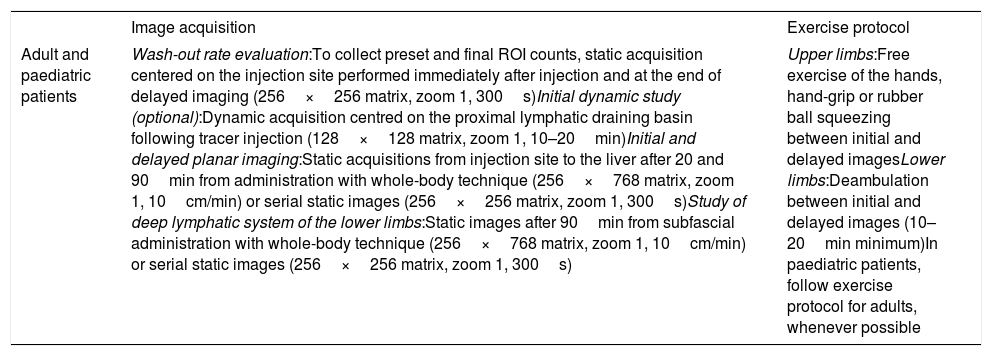Lymphoscintigraphy represents the “gold standard” for diagnosis of lymphedema, but an important limitation is the lack of procedural standardization. The aim of this Italian expert panel was to provide a procedural standard for lymphoscintigraphy in the evaluation of lymphatic system disorders. Topic anaesthetic gels containing lidocaine should be avoided. Patients should remove compressive dressings. Total recommended activity for Tc-99m-nanocolloid administration in adults is 74MBq, or 37MBq per limb and per investigated compartment, in single or multiple aliquots. 2–3 subcutaneous injections should be performed (II–III±I interdigital space of each hand/foot), avoiding intravascular injection. Deep lymphatic system of lower limbs should be evaluated in presence of dermal back-flow or lymphatic stasis (1–2 subfascial administrations in retro-malleolar or plantar region). Planar images should be acquired from injection site to liver with whole-body or serial static acquisitions 20’ and 90’ after subcutaneous administration. Additional information on lymphatic pathways is obtained after a quick and/or prolonged exercise protocol. SPECT/CT is recommended to study the thoracic, abdominal and pelvic territories. When required, deep lymphatic system of lower limbs should be evaluated with static acquisition 90’ after subfascial administration. The report should describe administration and imaging procedure, exercise protocol, qualitative and semi-quantitative analysis (wash-out rate, Transport Index), potential sources of error. Due to the essential role fulfilled by lymphoscintigraphy in clinical management of primary and secondary lymphedema, an effort for the standardization of this technique should be made to provide the clinicians with a homogeneous and reliable technical methodology.
La linfogammagrafía representa el patrón para el diagnóstico del linfedema, pero una limitación importante es la falta de estandarización de los procedimientos. El objetivo de este panel de expertos italianos es proporcionar un estándar de procedimiento para la linfogammagrafía en la evaluación de los trastornos del sistema linfático. Se deben evitar los geles anestésicos tópicos que contengan lidocaína. Los pacientes deben retirar los apósitos compresivos. La actividad total recomendada para la administración de Tc-99m-nanocoloides en adultos es de 74MBq, o 37MBq por miembro y por compartimento investigado, en alícuotas simples o múltiples. Se deben realizar 2-3 inyecciones subcutáneas (II-III±I espacio interdigital de cada mano/pie), evitando la inyección intravascular. El sistema linfático profundo de los miembros inferiores debe evaluarse en presencia de reflujo dérmico o estasis linfática (1-2 administraciones subfasciales en la región retro-malolar o plantar). Las imágenes planares deben ser tomadas desde el sitio de la inyección hasta el hígado con adquisiciones estáticas de cuerpo entero o en serie de 20’ y 90’ después de la administración subcutánea. Se obtiene información adicional sobre las vías linfáticas después de un protocolo de ejercicio rápido y/o prolongado. Se recomienda SPECT/TC para estudiar los distritos torácicos, abdominales y pélvicos. Cuando sea necesario, el sistema linfático profundo de los miembros inferiores debe ser evaluado con adquisición estática a 90’ después de la administración subfascial. El informe debe describir el procedimiento de administración e imágenes, el protocolo de ejercicio, el análisis cualitativo y semicuantitativo (tasa de lavado, índice de transporte) y las posibles fuentes de error. Dado el papel esencial que desempeña la linfogammagrafía en el tratamiento clínico del linfedema primario y secundario, se debe hacer un esfuerzo para la estandarización de esta técnica a fin de proporcionar a los médicos una metodología técnica homogénea y fiable.
Article
If you experience access problems, you can contact the SEMNIM Technical Secretariat by email at secretaria.tecnica@semnim.es or by phone at +34 619 594 780.

Revista Española de Medicina Nuclear e Imagen Molecular (English Edition)









